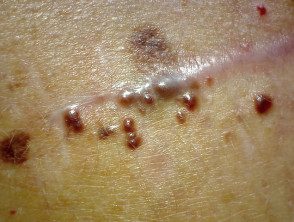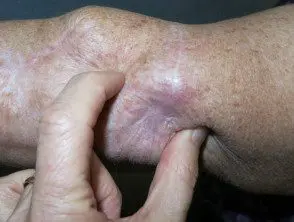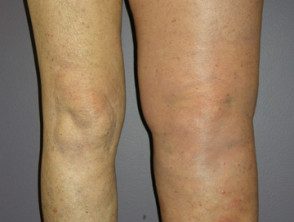What is ipilimumab?
In March 2011, ipilimumab (YERVOY ™; Bristol-Myers Squibb) obtained approval from the US Food and Drug Administration (FDA) for the treatment of adult patients with stages III to IV. melanoma does not respond to previous therapy (stage IV disease, metastatic melanoma) [1].
Metastatic melanoma

Metastatic melanoma

Metastatic melanoma

Metastatic melanoma
Mechanism of action of ipilimumab.
Regulatory pathways that limit the immune response to Cancer they are characterizing themselves well. Ipilimumab is fully human monoclonal antibody which activates the body's immune system to fight melanoma by inhibiting cytotoxic T lymphocyte-associated antigen 4 (CTLA-4) molecule [1,2].
CTLA-4 is a molecule on T cells that plays a critical role in the regulation of natural immune responses. The presence of CTLA-4 suppresses the immune system's response to disease, so blocking its activity stimulates the immune system to fight melanoma.
Key evidence from clinical trials for ipilimumab
Three previous early phase (phase II) clinical trials have shown that ipilimumab treatment results in a one-year survival rate of 47% to 51% for people with stage III or IV melanoma, which is almost twice the number that is not in this treatment [3,4].
Ipilimumab has also been tested in advanced trials (phase III) by itself and in combination with vaccines, other immunotherapies (as interleukin-2), and chemotherapies (such as dacarbazine). Overall response rates ranged from 13% with ipilimumab plus vaccine in patients with stage IV disease to 17% and 22%, with ipilimumab plus dacarbazine or interleukin-2, respectively, in patients with metastatic disease. Responses have been long-lasting, with more than a third of ipilimumab-treated patients with advanced melanoma experiencing a long-term survival benefit.
Recently published results from a phase III randomized controlled trial have shown a significant first overall survival benefit with ipilimumab compared to a cancer vaccine comprising HLA-A * 0201 - restricted peptides derived from melanosomal protein, glycoprotein 100 (gp100) in patients with metastatic melanoma, previously unsuccessfully treated with aldesleukin, dacarbazine, temozolomide, fotemustine, or carboplatin [5]. Ipilimumab, at a dose of 3 mg per kilogram of body weight, was administered intravenously with or without gp100 (2 mg peptide for deep SC) every 3 weeks for up to four treatments.
- Median overall survival was 10.0 months among 403 patients who received ipilimumab plus gp100, compared with 6.4 months among 136 patients who received gp100 alone (statistically significant, P <0.001).
- Median overall survival with ipilimumab alone (in 137 patients) was 10.1 months (P = 0.003).
- No differences in overall survival were detected between the ipilimumab groups (P = 0.76).
- Grade 3 or 4 related to the immune system adverse events it occurred in 10-15% of patients treated with ipilimumab and in 3% treated with gp100 alone. The most common related to the immune system. adverse event was diarrhea, which occurred in any grade in 27-31% of patients in the ipilimumab groups.
Based on these results, the US FDA granted marketing approval for ipilimumab as a second-line treatment for metastatic melanoma in adult patients. The FDA noted in its approval announcement that common adverse effects that can result from autoimmune Reactions associated with the use of ipilimumab include fatigue, diarrhea, skin. eruption, endocrine deficiencies (gland or hormone), and inflammation of the intestinescolitis) Severe autoimmune reactions and some fatal ones were observed in 12.9% of patients treated with ipilimumab. Due to the unusual and severe adverse effects associated with ipilimumab, the therapy was approved with a Risk Assessment and Mitigation Strategy to inform healthcare professionals of these serious risks. A Medication Guide has also been provided to patients to inform them of possible adverse effects of therapy.
Ipilimumab in combination with nivolumab
Safety and effectiveness of nivolumab in combination with ipilimumab and nivolumab monotherapy for the treatment of advanced melanoma (unresectable or metastatic) were evaluated in a phase 3, randomized, double-blind study [6].
A total of 945 patients were randomized to receive nivolumab in combination with ipilimumab (n = 314), nivolumab as monotherapy (n = 316), or ipilimumab as monotherapy (n = 315).
Patients in the combination group received nivolumab 1 mg / kg for 60 minutes and ipilimumab 3 mg / kg for 90 minutes given intravenously every 3 weeks for the first 4 doses, followed by nivolumab 3 mg / kg as monotherapy every 2 weeks. .
Patients in the nivolumab monotherapy group received nivolumab 3 mg / kg every 2 weeks.
Patients in the comparison group received ipilimumab 3 mg / kg and nivolumab combined placebo intravenously every 3 weeks for 4 doses followed by placebo every 2 weeks.
Treatment continued as long as clinical benefit was observed or until treatment was no longer tolerated. Tumor evaluations were conducted 12 weeks later randomization then every 6 weeks for the first year, and every 12 weeks thereafter. The co-primary The outcome measures were progression-free survival and overall survival.
At a minimum follow-up of 60 months, the median overall survival was more than 60.0 months (median not reached) in the nivolumab-plus-ipilimumab group and 36.9 months in the nivolumab group, compared with 19.9 months in the nivolumab group. of ipilimumab (nivolumab plus ipilimumab vs. ipilimumab death hazard ratio 0.52; nivolumab vs. ipilimumab hazard ratio 0.63).
Overall survival at 5 years was 52% in the nivolumab plus ipilimumab group and 44% in the nivolumab group, compared to 26% in the ipilimumab group.
No sustained deterioration in health-related quality of life was observed during or after treatment with nivolumab plus ipilimumab or with nivolumab alone.
Thus, among patients with advanced melanoma, sustained long-term overall survival at 5 years was observed in a higher percentage of patients receiving nivolumab plus ipilimumab or nivolumab alone than in those receiving ipilimumab alone, with no apparent loss of quality of life in patients who received regimens containing nivolumab.
Assistant ipilimumab versus high-dose interferon alfa 2b
The currently approved adjuvant ipilimumab dose of 10 mg / kg IV was higher toxic and not higher in efficacy to interferon alpha 2b. In contrast, adjuvant therapy with ipilimumab 3 mg / kg benefited survival versus high-dose interferon alfa 2b with a significant improvement in overall survival [7].
1,670 adult patients with resection cutaneous melanoma were randomly assigned (1: 1: 1) to ipilimumab 3 mg / kg (n = 523), high-dose interferon alfa 2b (n = 636), or ipilimumab 10 mg / kg (n = 511).
The comparison of ipilimumab 5 mg / kg versus high-dose interferon alfa 2b used an intention-to-treat analysis of 1,051 cases and showed a significant overall survival difference in favor of ipilimumab 3 mg / kg (hazard ratio [HR], 0 , 78, 95.6% repeated confidence interval [CI], 0.61–0.99, P = 0.044; Relapse free survival: HR, 0.85; 99.4% IC, 0.66-1.09; p = 0.065). For ipilimumab 10 mg / kg versus high dose interferon alfa 2b (n = 989), the trends in favor of ipilimumab 10 mg / kg did not reach statistical significance.
Grade ≥ 3 treatment-related adverse events occurred in 37% of patients receiving ipilimumab 3 mg / kg, 79% receiving high-dose interferon alfa 2b, and 58% receiving ipilimumab 10 mg / kg.
Pembrolizumab vs ipilimumab
KEYNOTE-006 was a open, multicenter, randomized, controlled, phase 3 study conducted in 87 academic institutions, hospitals, and cancer centers in 16 countries [8].
Patients (n = 834) were at least 18 years of age with an Eastern Cooperative Oncology Group performance status of 0 or 1, ipilimumab-naive, and histologically Confirmed advanced melanoma with known BRAFV600 status with up to one prior systemic therapy.
Patients were randomly assigned to intravenous pembrolizumab 10 mg / kg every 2 weeks (n = 279) or every 3 weeks (n = 277) or four doses of intravenous ipilimumab 3 mg / kg every 3 weeks (n = 278).
Pembrolizumab treatment continued for up to 24 months.
Median overall survival was 32.7 months (95% CI 24.5–41.6) in the combined pembrolizumab groups and 15.9 months (13.3–22.0) in the ipilimumab group (Hazard Ratio [HR] 0.73, 95% CI: 0.61 to 0.88, p = 0.00049).
The median progression-free survival was 8.4 months (95% CI 6.6-11.3) in the combined pembrolizumab groups versus 3.4 months (2.9-4.2) in the ipilimumab group (HR 0.57, 95% CI 0.48-0.67, p < 0,0001).
Grade 3-4 treatment-related adverse events occurred in 96 (17%) of 555 patients in the combined pembrolizumab groups and in 50 (20%) of 256 patients in the ipilimumab group; The most common of these events was colitis (11). [2%] vs 16 [6%]), diarrhea (ten [2%] vs seven [3%]) and fatigue (four [<1%] vs tres [1%])
Pembrolizumab continued to show superiority over ipilimumab after almost 5 years of follow-up.
Adverse events of ipilimumab
Ipilimumab can cause serious and fatal immune-mediated reactions due to T cell activation and proliferation [8]. These are:
- Immune-mediated enterocolitis
- Immunomediated hepatitis
- Immunomediated dermatitis
- Immune-mediated neuropathies
- Immunomediated endocrinopathies, as hypophysitis
- Other immune-mediated Adverse reactions, including ocular manifestations
In the case of any of these adverse events, ipilimumab should be discontinued and treatment should be started with systemic corticosteroids, that is, prednis (ol) one or equivalent. After improvement, corticosteroids should be gradually reduced.
Vitiligo has been reported to be an adverse effect of ipilimumab. Vitiligo has been thought to be a good forecast factor in metastatic melanoma.
Dosage and administration of ipilimumab.
The recommended dose of ipilimumab is 3 mg / kg given intravenously over 90 minutes every 3 weeks for a total of four doses. [8].
For any moderate immune-mediated adverse reaction or for symptoms endocrinopathy, the scheduled dose of ipilimumab should be withheld. For patients with complete or partial resolution of adverse reactions (Grade 0-1), and receiving less than 7.5 mg prednisone or equivalent per day, ipilimumab should be resumed at a dose of 3 mg / kg every 3 weeks until administration. of all 4 planned doses or 16 weeks from the first dose, whichever comes first.
Ipilimumab should be permanently discontinued for any of the following reasons:
- Moderate persistent adverse reaction(s) or inability to reduce corticosteroid dose to 7.5 mg prednisone or equivalent per day.
- Failure to complete full treatment within 16 weeks of first dose.
- Serious or life-threatening adverse reactions, such as colitis with abdominal pain, feverileus or peritoneal signs, increased frequency of stools (7 or more over base), fecal incontinence, need for intravenous hydration for more than 24 hours, gastrointestinal hemorrhageand gastrointestinal drilling.
- Aspartate aminotransferase (AST) or alanine aminotransferase (ALT)> 5 times the upper limit of normal or total bilirubin > 3 times the upper limit of normal.
-
Stevens-Johnson syndrome / toxic epidermal necrolysis or complicated full-thickness skin rash dermal ulcerationor necrotic, bullousor hemorrhagic manifestations.
- Severe motor or sensory neuropathy, Guillain-Barré syndrome or myasthenia gravis
- Severe immune-mediated reactions involving any organ system (eg, nephritis, pneumonitis, pancreatitis, non-infectious myocarditis)
- Immune-mediated eye disease that does not respond to current immunosuppressive therapy.
Contraindications to ipilimumab
None have been reported [8].
Drug interactions with ipilimumab
No formal drug interaction studies have been performed with ipilimumab.
Use of ipilimumab in specific populations.
There are no adequate and well-controlled studies of ipilimumab in pregnant women. Ipilimumab should be used during pregnancy only if the potential benefit justifies the potential risk to the fetus (pregnancy Category C) [1,8].
- It is not known whether ipilimumab is secreted in human milk. Due to possible adverse effects to the baby, a decision should be made to discontinue breastfeeding or ipilimumab, taking into account the importance of ipilimumab to the mother.
- The safety and efficacy of ipilimumab in children have not been established.
- In clinical trials, no overall differences in safety or efficacy were reported between older patients (65 years or older) and younger patients (less than 65 years old).
- There are no formal studies of ipilimumab in patients with renal Impairments have been made.
- There are no formal studies of ipilimumab in patients with hepatic Impairments have been made.
- The genotoxic potential of ipilimumab has not been evaluated.
- Fertility studies have not been performed with ipilimumab.
- the carcinogenic The potential of ipilimumab has not been evaluated in long-term animal studies.
- It is unknown whether ipilimumab should be used before or after. BRAF inhibitor therapy in patients suitable for both treatments.
Ipilimumab overdose
There are currently no data available on overdose with ipilimumab.

